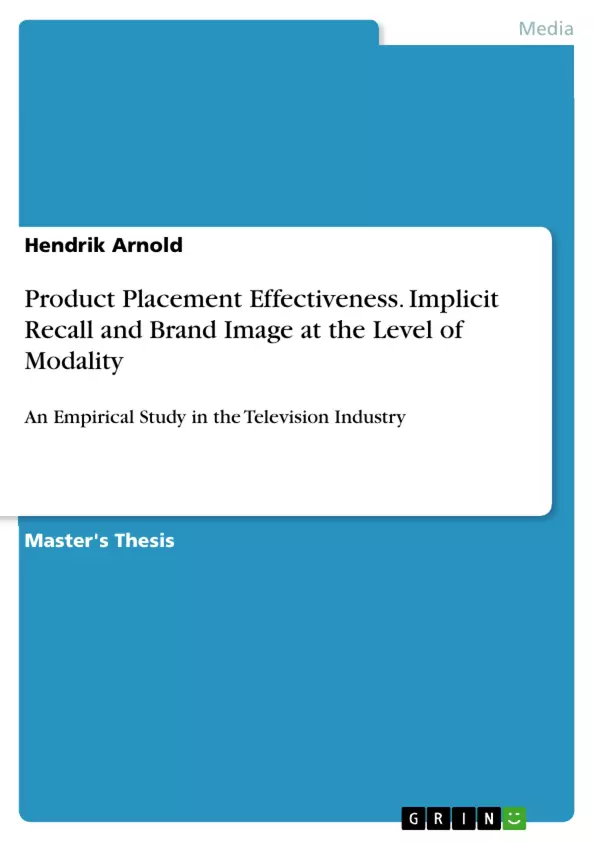Product placement effectiveness currently receives much attention regarding explicit recall, general attitude and brand attitude. However, few studies investigate the impact on implicit recall and brand image. This study tries to fill these gaps, using modality to distinguish placements. It is hypothesized that audio-only placements perform more effectively than visual–only ones and that audio-visual placements outperform both of the former in terms of both, implicit recall and brand image. Furthermore, two moderating effects are hypothesized, namely perceived congruence and prior notifications. Anderson and Bower’s (1973) HAM theory as well as KPM (Friestad & Wright, 1994, 1995) and the concept of reactance (Brehm, 1981) are used to predict the respective effects. An online questionnaire is used to collect quantitative data from 257 respondents using sequences from the TV show Modern Family. The findings reveal that changing modality indeed leads to better recall and increasing brand image, which is in line with the respective hypotheses. The evaluation of the moderation effects provides mixed results of significance. Theoretical and managerial implications of the findings are discussed in detail and finally, limitations and potential avenues for future research are defined.
Inhaltsverzeichnis (Table of Contents)
- Introduction
- Literature Review
- Conceptual Framework
- Placement Modality
- Implicit Recall
- Brand Image
- Perceived Congruence
- Prior Notifications
- Placement Modality
- Research Design
- Preliminary Study
- Methodology
- Data Analysis
- Main Study
- Preliminary Study
- Data Analysis
- Results
- Reliability, Validity, Assumptions and Preliminary Calculations
- Main Findings
- Implicit Recall
- Brand Image
- Results
- Implications
- Theoretical Implications
- Managerial Implications
- Limitations and Directions for Further Research
- Summary
Zielsetzung und Themenschwerpunkte (Objectives and Key Themes)
This study explores the effectiveness of product placement in influencing implicit recall and brand image. By investigating the impact of different placement modalities (audio-only, visual-only, and audio-visual), the study aims to determine which modality leads to the highest levels of implicit recall and positive brand image. The study also explores the moderating effects of perceived congruence and prior notifications. * The impact of product placement modality on implicit recall and brand image. * The effectiveness of different placement modalities (audio-only, visual-only, and audio-visual). * The moderating effects of perceived congruence and prior notifications on product placement effectiveness. * The theoretical implications of findings on product placement effectiveness. * The managerial implications for practitioners in the advertising and marketing industry.Zusammenfassung der Kapitel (Chapter Summaries)
The introduction provides an overview of the study's focus on product placement effectiveness, particularly in relation to implicit recall and brand image. It highlights the gap in existing research on these aspects and outlines the specific objectives of the study. The literature review provides a comprehensive overview of existing research on product placement effectiveness, focusing on the effects of modality, perceived congruence, and prior notifications. It discusses theoretical frameworks such as HAM theory, KPM, and the concept of reactance, which are relevant to the study's hypotheses. The conceptual framework section defines key concepts, including placement modality, implicit recall, brand image, perceived congruence, and prior notifications. It elaborates on the theoretical framework used to understand the relationships between these concepts. The research design section details the methodology used in the study, including the preliminary study and the main study. It describes the data collection methods, the sample, and the analytical techniques employed. The data analysis section presents the results of the study, focusing on the reliability, validity, and assumptions of the data. It presents the main findings on the effects of modality, perceived congruence, and prior notifications on implicit recall and brand image. The implications section discusses the theoretical and managerial implications of the study's findings, highlighting the contributions to the field of product placement research and practical applications for advertisers and marketers.Schlüsselwörter (Keywords)
The study focuses on the effectiveness of product placement in influencing implicit recall and brand image. This includes analyzing the impact of different modalities, such as audio-only, visual-only, and audio-visual placements, along with factors like perceived congruence and prior notifications. Key concepts include implicit memory, brand attitude, product involvement, and marketing communication strategies.- Quote paper
- Hendrik Arnold (Author), 2013, Product Placement Effectiveness. Implicit Recall and Brand Image at the Level of Modality, Munich, GRIN Verlag, https://www.grin.com/document/209464



